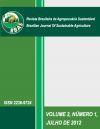DISPERSION OF CLAY CAUSED BY FERTIRRIGATION WITH ANIMAL WASTEWATER
DOI:
https://doi.org/10.21206/rbas.v2i1.62Abstract
The objective of the experiment was to evaluate the dispersion of clay in soil prevalent in the area of Rio Pomba/MG, by indiscriminate application of wastewater of breeding of cattle, pigs and rabbits. Soil samples were collected in the B horizon of an Oxisol. The work consisted of two experiments, one with soil incubation in pots for 20 days at doses of 72 mm of wastewater, and the second was realized by the application of the same wastewater in the soil placed in a permeameter of vertical column with constant load. In this case, the wastewater was applied until the electrical conductivity (EC) in the effluent of the columns approached the EC of the effluent. All treatments were conducted with three repetitions in a completely randomized design. In the first experiment the values of water dispersible clay (WDC)did not differ significantly, ranging from 37 to 40%. In the second experiment the values of WDC did not differ statistically, and were smaller, around 29-32%. The index of dispersion and flocculation of the wastewater was similar, differences occurring between the experiments, 61% and 39% for the first experiment and 48%and 52% for the second experiment. However, these waters do not present any restriction on its use in irrigation, but when practicing successive irrigations over time without specialized monitoring agronomic, can promote the accumulation of dispersant compounds in soil solution, affecting its structure.Downloads
Downloads
Published
2012-07-01
How to Cite
Bruno Grossi Costa Homem, Onofre Barroca de Almeida Neto, Alberto Magno Ferreira Santiago, & Gustavo Henrique de Souza. (2012). DISPERSION OF CLAY CAUSED BY FERTIRRIGATION WITH ANIMAL WASTEWATER . Brazilian Journal of Sustainable Agriculture, 2(1). https://doi.org/10.21206/rbas.v2i1.62
Issue
Section
Artigos
License
1. Proposta de Política para Periódicos de Acesso Livre
Autores que publicam nesta revista concordam com os seguintes termos:
Autores mantém os direitos autorais e concedem à revista o direito de primeira publicação, com o trabalho simultaneamente licenciado sob a Licença Creative Commons Attribution que permite o compartilhamento do trabalho com reconhecimento da autoria e publicação inicial nesta revista.











